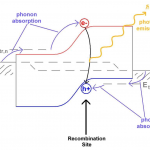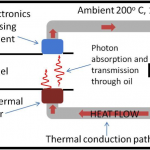Thermal Energy Harvesting Light Sources
- Category: Electronic Devices, Energy, Optics & Photonics
- Tags: Parthiban Santhanam, Rajeev Ram
We are investigating thermoelectric transport in light-emitting diodes (LEDs). Electro-luminescent cooling is a phenomenon in which the optical output power from an LED exceeds its electrical input power, resulting in a net cooling of the emitter. The physical process is outlined in Figure 1. Proposed in the 1950s [1] , electro-luminescent cooling has been a topic of recent theoretical interest [2] [3] , but there are no known reports that it has been experimentally observed. Additionally, this investigation could lead to practical light emitters operating with efficiencies approaching or even surpassing unity.
The Second Law of Thermodynamics places limits on the power density achievable in these high-efficiency devices. Nevertheless, LEDs designed to exploit thermoelectric transport may find practical application in lighting, spectroscopy, and communication.
Since such devices would see improved efficiency at higher ambient temperatures, this work could lead to LED designs that do not suffer from efficiency droop, a major hurdle for state-of-the-art LEDs [4] . If LED packaging was designed for the concentration of heat, just as in an incandescent filament, self-heating due to non-radiative recombination could raise the achievable power density at visible wavelengths to practical levels.
Remote and portable spectroscopy applications like pulse oximetry, infrared oilfield spectroscopy, and automotive emissions monitoring may benefit from such highly efficient photon sources. Drastically reduced power demands may increase the lifespan of such remote platforms, or even permit the use of ambient energy-harvesting power sources in place of batteries. The fundamental limitations on the power density of this technology do not impede this case, as the less-constricting power requirements for spectroscopic sources are set by the noise-equivalent power of the detector and the required signal-to-noise ratio. Similarly, since the power requirements for infrared optical communication are set by ambient blackbody radiation, the quality of the detector, and the desired bitrate, dim but efficient sources may prove practical.
- Figure 1: Band diagram of a p-n junction depicting thermoelectric heat-exchange processes involved in electro-luminescent cooling. Entropy and energy are absorbed, in the form of phonons, by the electrons and holes as they climb their respective electrical potential energy hills. Radiative recombination results in the rejection of this entropy and energy, along with some external work, through photons.
- Figure 2: Potential downhole spectroscopy system configuration. Since the efficiency and power of the emitter technology improve with heating, the emitter could be installed at the site of heat rejection for any actively cooled components.
- J. Tauc, “The share of thermal energy taken from the surroundings in the electro-luminescent energy radiated from a p-n junction,” Czechoslovak Journal of Physics, vol. 7, no. 3, pp. 275-276, Jan. 1957. [↩]
- O. Heikkilä, J. Oksanen, and J. Tulkki, “Ultimate limit and temperature dependency of light-emitting diode efficiency,” Journal of Applied Physics, vol. 105, pp. 093119:1-9, May 2009. [↩]
- P. Han, K.-J. Jin, Y.-L. Zhou, H.-B. Lu, and G.-H. Yang, “Numerical designing of semiconductor structure for optothermionic refrigeration,” Journal of Applied Physics, vol. 101, pp. 014506:1-4, Jan. 2007. [↩]
- J. Piprek, “Efficiency droop in nitride-based light-emitting diodes,” Phys. Status Solidi A, vol. 207, no. 10, pp. 2217-2225, July 2010. [↩]

